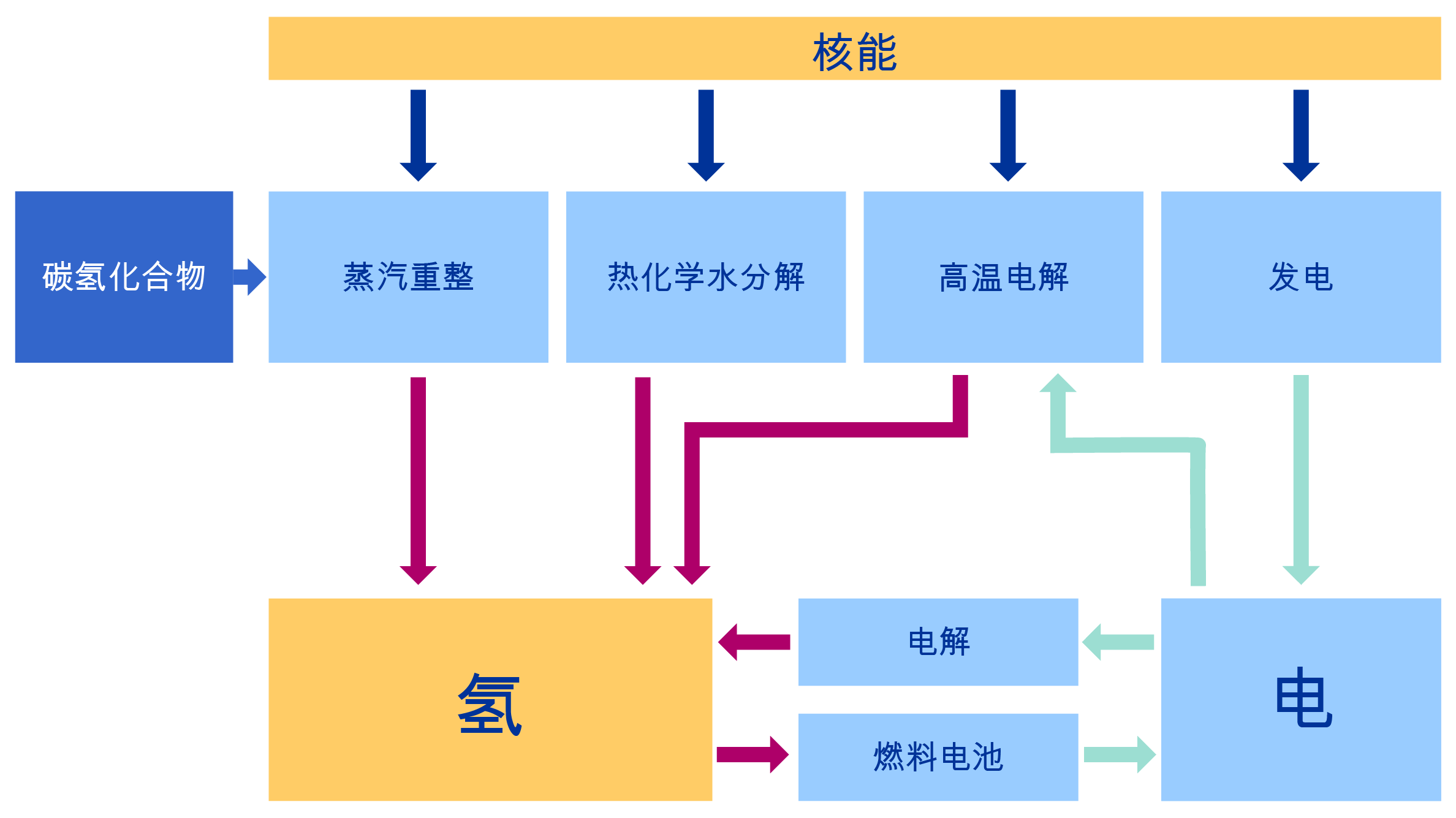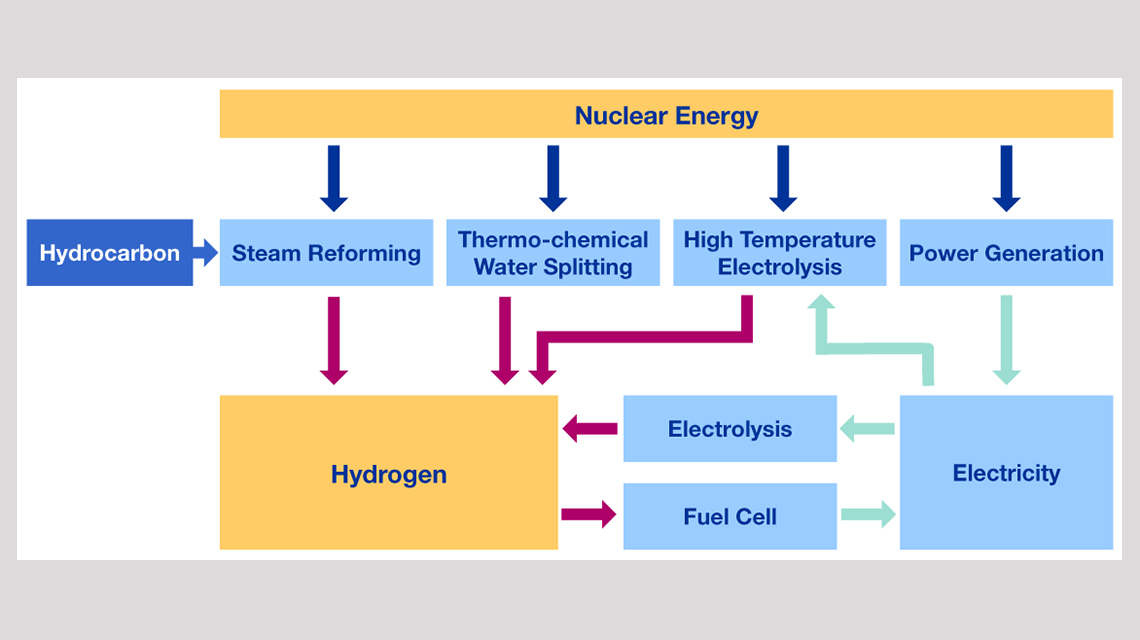脱碳的目的是打造一种二氧化碳中性的全球经济,这需要对当前主要依赖化石燃料的所有部门进行脱碳,其中包括供热、需要燃烧的工业过程和运输,特别是重工业、海运和空运。根据国际能源机构的数据,核能发电量约占全球总发电量的10%,是仅次于水电的世界第二大低碳能源。核能还可用于非电力应用的脱碳。
发电之外的核动力应用:非电力应用
脱碳的目的是打造一种二氧化碳中性的全球经济,这需要对当前主要依赖化石燃料的所有部门进行脱碳,其中包括供热、需要燃烧的工业过程和运输,特别是重工业、海运和空运。
什么是非电力应用?
除了发电,可以利用核动力的应用还有很多。这些需热应用包括海水淡化、氢生产、地区供热、工业过程供热(玻璃和水泥制造、金属生产)、炼油和合成气生产。随着国际社会努力实现气候目标,扩大核能在这些应用中的作用可能是成功实现清洁能源转型的关键。
核电厂产生的热量可用于产生蒸汽,而蒸汽可驱动涡轮机发电。目前,现有核电厂运行温度可达300℃,而地区供热和海水淡化过程需要大约150℃。由于主要涉及材料属性和性能的一些技术原因,各核电厂目前按设计可将所产生热量的三分之一转化为电力。剩余的热量通常释放到环境中。
这些热量若不释放,则可用于供热或制冷,或者用作生产淡水、氢或诸如石油或合成燃料等其他产品的能源。这些产品可以由现有发电厂生产,也就是所谓的热电联产。核热电联产就是电力生产与供热或供热衍生产品生产同步。通过将热量用于热电联产,热效率可提高到80%。
什么是核能?核电厂如何运行?参阅核动力科学。
核电与氢生产
氢可以在多个领域取代化石燃料,有潜力在化学和工业过程、清洁能源系统和运输中实现零排放或近零排放。根据国际能源机构的数据,目前通过甲烷蒸汽重整过程生产氢的工艺是一个能源密集型过程,每年排放约8.3亿吨二氧化碳,相当于英国和印度尼西亚二氧化碳排放量之和。利用核能作为电源和热源高效生产氢的方法有若干种,二氧化碳排放量极少,甚至没有。
核电与地区供热
地区供热依靠集中式能源厂为住宅和商业建筑配送热能。在核地区供热中,核电厂产生的蒸汽为区域供热管网提供热能。保加利亚、中国、捷克共和国、匈牙利、罗马尼亚、俄罗斯、斯洛伐克、瑞士和乌克兰等国已经实施了这一做法。
世界首座浮动核电厂阿卡德米科·罗蒙诺索夫号于2020年5月投入商业运营,为俄罗斯遥远的东北部楚科奇地区供热。自1983年以来,瑞士的贝兹瑙核电厂一直为市政、私人、工业和农业消费者共计约两万人供热。主干供热管网长31公里,向总长99公里的次级管网输送热能。
在中国,海阳核能供热项目正在扩大。供热管网利用了海阳两座反应堆所产生的蒸汽,已于2020年底投入运营。项目一期预计每年可减少燃煤2.32万吨,减少二氧化碳排放六万吨。此供热项目是核能如何在住宅供热脱碳中发挥作用的一个例子,也是以热电联产模式运行核电厂的增值体现。到2021年底,该项目将为整个海阳市供热。这是山东省的一个沿海城市,人口约67万。
核电与海水淡化
海水淡化有助于满足对饮用水日益增长的需求,同时缓解许多干旱或半干旱沿海地区的淡水短缺问题。海水淡化厂要么需要热能用于蒸馏,要么需要电能/机械能来驱动水泵,对海水施加压力,使其通过渗透膜,从而将盐从含盐水中分离出来。目前,所需能源大部分来自化石燃料。核能海水淡化是利用核反应堆热量和电力的一种低碳替代方案。海水淡化技术可以与不同类型的核电厂配套,同时生产淡水和电力。
综合核能海水淡化厂的可行性已通过主要在印度、日本和哈萨克斯坦的150堆年以上的经验得到了证明。哈萨克斯坦的阿克图核反应堆位于里海岸边,在1999年关闭之前的27年间,其电力生产达135兆瓦(电),日产饮用水八万立方米。日本有若干海水淡化设施与核反应堆相连,日产饮用水约1.4万立方米。2002年,在印度东南部的马德拉斯原子能电站建立了一个与两座170兆瓦(电)核反应堆配套的示范厂,是基于利用海水和核电厂低压蒸汽的混合热渗透技术的最大核能海水淡化厂。
非电力应用倡议
虽然目前只有大约1%的核能用于非电力应用,但从英国和法国到俄罗斯、日本等国家,世界各地都在发起倡议,为更广泛采用核能铺平道路。其中包括美国于2016年发起的H2-@-Scale倡议,旨在研究利用核能进行氢生产的前景。在加拿大,加拿大核实验室正计划启动清洁能源示范、创新和研究园区,作为利用小型模块堆的热电联产应用试验场。
在中国,一座小型模块式高温气冷堆计划于2021年底投入运行。该反应堆的设计旨在支持发电、热电联产、工艺热和氢生产。日本于2021年7月重启了高温工程试验堆,其产生的热量可用于发电、海水淡化和热化学制氢。
在250-550℃温度范围内,欧洲供热市场容量超过100吉瓦(热),核能有机会供应这个市场。波兰100%依赖化石燃料进行热生产;但该国的发展战略中包括核能供热部署。
原子能机构的作用是什么?
- 原子能机构通过科学技术出版物、网络研讨会和协调研究项目支持和促进发展核技术新的和正在出现的非电力应用。
- 为了评定氢生产方案,原子能机构开发了软件工具,如氢生产经济性评价程序和氢计算器。这里有下载这两种工具的链接。
- 为了评定核能海水淡化,原子能机构开发了海水淡化经济性评价程序和海水淡化热力学优化程序,对与各种海水淡化工艺配套的不同动力资源进行经济、热力学和优化分析。这些软件可在这里下载。
- 自1989年以来,原子能机构一直在协调有关核能海水淡化的可行性研究。原子能机构核能海水淡化技术工作组是一个全球专家网络,支持核能海水淡化厂的计划评定和规划、研究、开发、设计、建造、经济性、安全方面、示范项目国际合作以及运行和维护。
What are non-electric applications?
There are many applications beyond electricity generation that can use nuclear power. These applications, which require heat, include seawater desalination, hydrogen production, district heating and process heating for industry (glass and cement manufacturing, metal production), refining and synthesis gas production. As the global community strives to meet climate goals, expanding nuclear’s role in these applications could be key to a successful clean energy transition.
Learn how nuclear can replace coal as part of the clean energy transition.
The heat produced by nuclear power plants is used to create steam, which drives electricity-generating turbines. Existing nuclear fleets today reach operating temperatures in the range of 300°C, while district heating and seawater desalination processes require about 150°C. By design, nuclear power plants currently convert one third of the heat produced into electricity because of technological reasons mostly related to material properties and performances. The remaining heat is usually released to the environment.
Instead of releasing this heat, it could be utilized for heating or cooling, or as an energy source towards the production of fresh water, hydrogen or other products, such as oil or synthetic fuel. These products may be produced by existing power plants, in what is referred to as cogeneration. Nuclear cogeneration is the simultaneous production of electricity and heat or a heat-derivative product. By using heat for cogeneration, the thermal efficiency can be improved up to 80 per cent.
What is nuclear energy, and how does a nuclear power plant work? Read about the science of nuclear power.
Nuclear power and hydrogen production
Hydrogen can replace fossil fuels across multiple sectors to potentially enable zero or near-zero emissions in chemical and industrial processes, clean energy systems and transportation. Hydrogen is produced today from the steam methane reforming process, an energy-intensive process that emits around 830 million tonnes of CO2 per year, equivalent to the CO2 emissions of the United Kingdom and Indonesia combined, according to the IEA. There are several methods to use nuclear energy, as a source of electricity and heat, to produce hydrogen efficiently and with little to no CO2 emissions.
Nuclear power and district heating
District heating relies on a centralized energy plant for the distribution of heat to residential and commercial buildings. In nuclear district heating, steam produced by a nuclear power plant serves to heat regional heating networks. This practice has been implemented in several countries – Bulgaria, China, Czech Republic, Hungary, Romania, Russia, Slovakia, Switzerland and Ukraine.
The Akademik Lomonosov, the world’s first floating nuclear power plant that began commercial operation in May 2020, provides heat to the Chukotka region in far northeastern Russia. Since 1983, Switzerland’s Beznau nuclear power plant has been providing heat for municipalities, private, industrial and agricultural consumers totalling about 20 000 people. The main heating network has a length of 31 km, from which heat is transferred to secondary networks with a total length of 99 km.
In China, the Haiyang Nuclear Energy Heating Project is expanding. The heating network using steam from Haiyang's two reactors became operational at the end of 2020, and the first phase of the project is expected to avoid the use of 23 200 tonnes of coal annually and the emission of 60 000 tonnes of CO2. The Heating Project is an example of how nuclear energy can play a role in decarbonizing residential heating, as well as the added value of operating a nuclear power plant in cogeneration mode. The project will provide heat to the entire city of Haiyang, a coastal city in Shandong province that has a population of about 670 000, by the end of 2021.
Nuclear power and desalination
Desalination of seawater can help to meet the growing demand for potable water, while alleviating water shortages in many arid or semi-arid coastal areas. Desalination plants require energy in the form of heat for distillation or electrical/mechanical energy to drive pumps for pressurization of seawater across membranes to separate salt from saline waters. Currently most of this energy is derived from fossil fuels. Nuclear desalination is a low-carbon alternative that utilizes the heat and electricity from a nuclear reactor. Desalination techniques can be coupled with different types of nuclear power plants to produce water and electricity concurrently.
The feasibility of integrated nuclear desalination plants has been proven with over 150 reactor-years of experience, mainly in India, Japan and Kazakhstan. The Aktau nuclear reactor in Kazakhstan, on the shore of the Caspian Sea, produced up to 135 MWe of electricity and 80 000 m3/day of potable water for 27 years until it was shut down in 1999. In Japan, several desalination facilities linked to nuclear reactors produce about 14 000 m3/day of potable water. In 2002, a demonstration plant coupled to twin 170 MWe nuclear power reactors was set up at the Madras Atomic Power Station, in southeast India. This is the largest nuclear desalination plant based on hybrid thermal and osmotic technology using seawater and low-pressure steam from a nuclear power station.
Initiatives for non-electric applications
Though only about 1 per cent of nuclear energy is currently used for non-electric applications, there are initiatives around the world from the United Kingdom and France to Russia, Japan and beyond, to pave the way for broader adoption. This includes the H2-@-Scale initiative, launched in 2016 by the United States, which examines the prospects for hydrogen production via nuclear power. In Canada, the Canadian Nuclear Laboratories (CNL) are planning to launch the Clean Energy Demonstration, Innovation, and Research (CEDIR) Park, which will serve as a testing site for cogeneration applications using small modular reactors (SMRs).
In China, a high-temperature gas cooled SMR, is slated to begin operation by the end of 2021. The reactor is designed to support electricity generation, cogeneration, process heat and hydrogen production. Japan restarted its High-Temperature Engineering Test Reactor (HTTR) in July 2021. The heat produced by the HTTR has applications for power generation, desalination of seawater and hydrogen production via thermochemical process.
In the range of 250-550°C, the European heat market represents more than 100 gigawatts-thermal (GWth), and there is an opportunity for nuclear to address this market. Poland relies 100 per cent on fossil fuel for heat production; however, the deployment of nuclear for heat is included in the country’s development strategy.
What is the role of the IAEA?
- The IAEA supports and facilitates the development of new and emerging non-electric applications of nuclear technologies through scientific and technical publications, webinars and coordinated research projects.
- The IAEA has developed software tools, such as the Hydrogen Economic Evaluation Program (HEEP) and Hydrogen Calculator, to assess options for hydrogen production. Links to download both tools are available here.
- To assess nuclear desalination, the IAEA has developed the Desalination Economic Evaluation Program (DEEP) and the DEsalination Thermodynamic Optimization Programme (DE-TOP) to perform economic, thermodynamic and optimization analyses of different power resources coupled to various desalination processes. The software are available for download here.
- The IAEA has been coordinating feasibility studies on nuclear desalination since 1989. The IAEA Technical Working Group on Nuclear Desalination is a global network of experts that supports programme assessment and planning, research, development, design, construction, economics, safety aspects, international collaboration for demonstration projects, and operation and maintenance of nuclear desalination plants.


